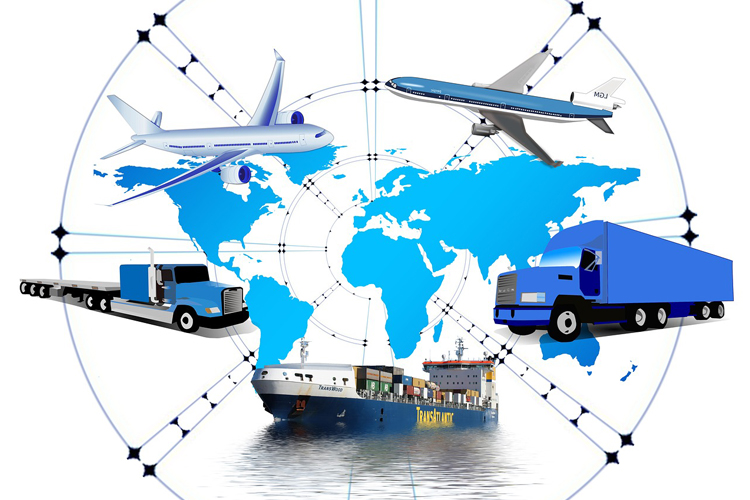As consumers, we have become accustomed to the ease and convenience of the modern world and seldom stop to think about what it takes to fill our grocery stores, retail outlets, and even online marketplaces with the goods and products we use daily. But when the world suddenly came to a halt in 2020, the term “supply chain” was thrust into the forefront of many people’s day-to-day lives.
For many, the terms supply chain management and logistics are synonymous, but there is a distinct difference between the two.
In today’s Manex blog, we are going to unravel some of the mystery behind the supply chain, as we seek to answer the question: “Is logistics the same as supply chain management?” Let’s dig in!

What Exactly is Supply Chain Management?
For every good or item that is produced in the world, there is an accompanying supply chain.
The supply chain includes not only the manufacturer of the product, but also the suppliers of any raw materials or components that are used in its production. Supply chains encompass each of the individuals, organizations, and even the knowledge itself involved in the manufacturing of the end product.
But the supply chain doesn’t end there. A supply chain also includes the vehicles that are used to transport the raw materials and components to the manufacturer, the warehouses used to store materials, as well as the transportation used to deliver the finished product to the retailer or end user.
Many products include dozens, even hundreds, of links in their supply chain. The process of coordinating each and every aspect of this complex chain is known as supply chain management (SCM). It is a crucial skill that must be carefully managed by businesses to keep costs in line, maintain efficiency, and maximize profits.
Some of the most common components in supply chain management include:
- Producers – Those who produce either raw materials or finished goods.
- Vendors – Partner companies who sell components or provide services required to manufacture the final product.
- Warehouses – Where materials and products are stored until needed.
- Transportation Companies – Responsible for moving supplies and products from one location to another.
- Distribution Centers – Regional facilities where the manufacturer delivers products to be stored until sent to retailers.
- Retailers– Where the goods are ultimately delivered to be purchased by the end user.
What is Logistics?
Logistics is focused all the aspects of the supply chain needed to coordinate, move, store, and deliver the raw materials, components, and finished products involved in the overall supply chain.
Logistics essentially boils down to how resources and goods are moved and stored throughout the supply chain. Logistics requires large amounts of data to track products, so that decisions can be made to ensure there is enough product available to retailers and delivered on time.
While supply chain management can be seen as the larger, overarching concept in the production of goods, logistics is a specific link in the overall supply chain. Logistics is crucial to keeping things moving along, and avoiding delays or downtime in delivery and fulfillment.
How Logistics and Supply Chain Management Work Together
Now that we understand that logistics is a piece of the larger supply chain puzzle, let’s look at a practical example of how they work together.
Imagine you are shopping for a pair of jeans at the mall. There are dozens of different styles of jeans for you to compare, and each pair has undergone a similarly lengthy journey to arrive in the store.
Here is how logistics and supply chain management work together to make these jeans available to consumers:
Supply Chain
- Strategic Planning – Before a manufacturer begins production, they use strategic planning to determine variables such as the quantity of sizes, styles and colors they will need to produce for a given season. With these numbers determined, they calculate the quantity of raw materials, such as cotton, that will be needed to produce the jeans.
- Securing Resources – The next step in SCM involves sourcing the suppliers of the raw materials needed. In our example of jeans, this would include the thread, zippers, and cotton needed to produce them. A key aspect of this stage of SCM is building strong relationships with suppliers, which can be crucial to providing consistent quality and ensuring deadlines are met.
- Production – In this stage of supply chain management, production schedules are created to ensure there are enough materials to meet the production demands for the jeans. Balancing the various resources required with the production schedule is a key aspect of an efficient supply chain.
Logistics
When the jeans have been manufactured, the next phase requires the coordination of logistics to move the supplies of jeans to the retailer or end consumer.
Some of the most important aspects of supply chain logistics include:
- Transportation – Logistics requires the coordination of the physical movement of supplies and products (many of which are produced overseas). This includes ships, trains, trucks, and other vehicles. It’s important that this be done in the most cost-effective way possible.
- Warehousing – When the jeans arrive in their destination country, they must be physically stored in warehouses until they are needed or ready for distribution.
- Inventory Management – Logistics uses careful planning to track the inventory of jeans produced, so that the right amount of product is available to meet demand, without needing to unnecessarily store unsold inventory.
- Fulfillment– When an order is placed by a retailer, the logistics of fulfillment spring into action to pluck items from the warehouse or distribution center, package them, and send them to the retailer, where they are ultimately placed on display.
Conclusion
By now, it’s clear that logistics and supply chain management are two related, yet distinct concepts. Supply chain management is the broad term for how raw materials and components come together in the creation of a product, while logistics is a vital tool that coordinates the storage and movement of resources to deliver the final product.
Whether you are shopping for jeans in the mall, or placing an order through your favorite online retailer, every single product we use is dependent on supply chain management and logistics to realize its long journey from raw materials, to finished product in your hands.
Ready to Level Up Your Supply Chain and Logistical Operations?
At Manex Consulting, we are dedicated to helping manufacturers improve their processes through education, coaching, and mentorship. We are the most hired manufacturing consultant in Northern California helping dozens of organizations streamline their operations and increase their bottom line.
When you are ready to take your business to the next level, contact Manex at 877.33.MANEX or email info@manexconsulting.com and let us show you how we can take your manufacturing performance to new heights.
Manex has joined the Sustainment Manufacturing Marketing Network to broaden our industry connections while highlighting our capabilities and certifications.
Sustainment is the leading online manufacturing community. The supplier relationship management platform enables Manex to:
- Manage NDAs
- Maintain Certifications
- Ensure Data Security
- Share Expertise
This is a historic opportunity for the U.S. manufacturing industry. Advances in technology and increasing geopolitical risk makes domestic production more attractive than it has been in decades. To capitalize on the moment, Sustainment developed a next-generation technology platform that connects local and regional suppliers into the most efficient, effective, and competitive market network in the world.
Connect with Manex on sustainment.com


